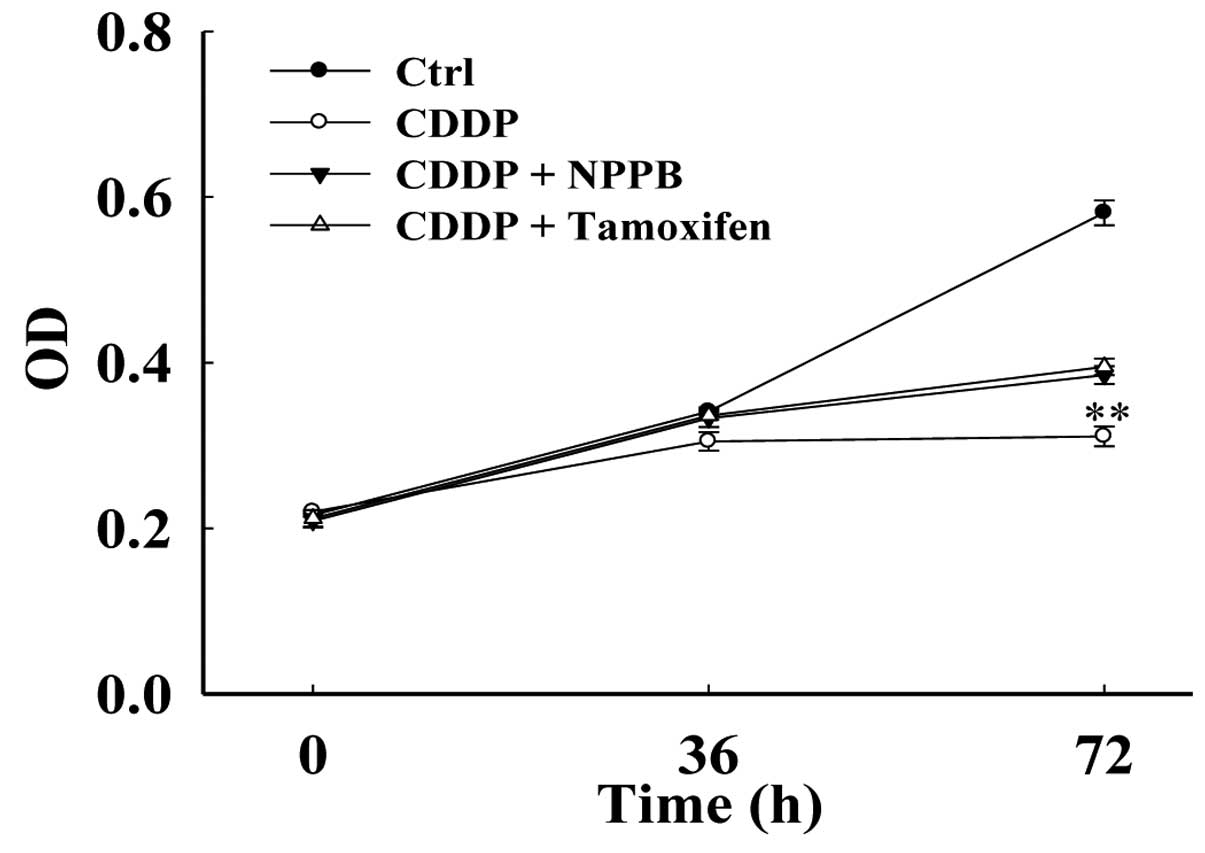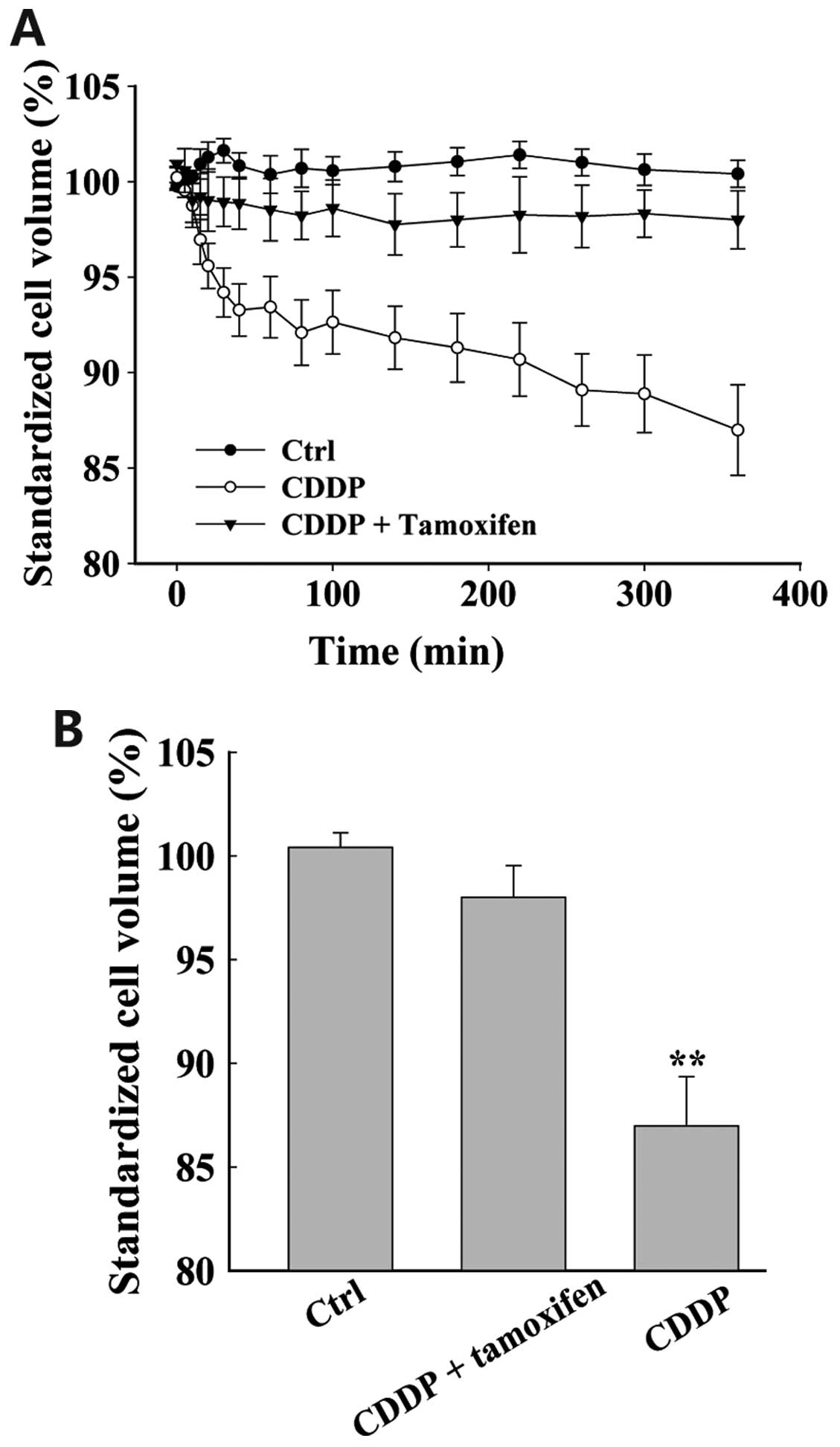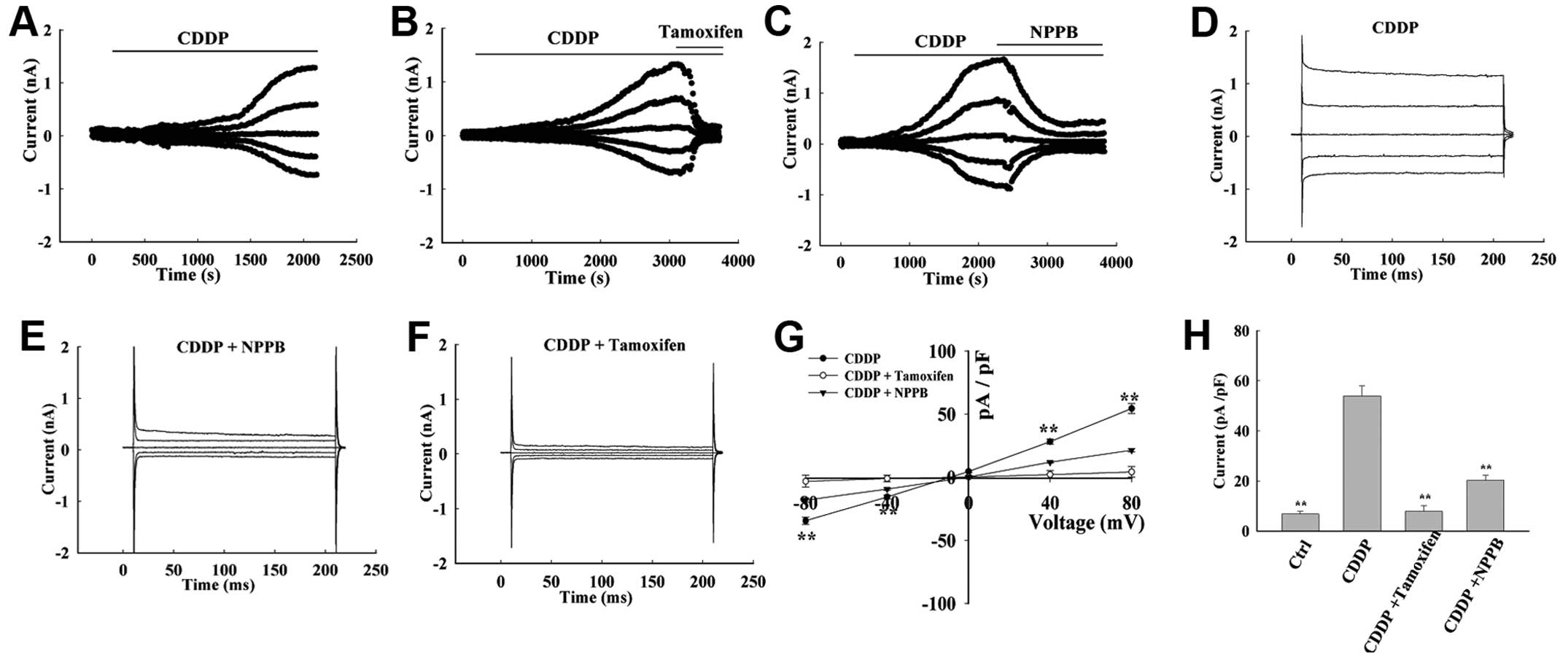|
1
|
Reedijk J: New clues for platinum
antitumor chemistry: kinetically controlled metal binding to DNA.
Proc Natl Acad Sci USA. 100:3611–3616. 2003. View Article : Google Scholar : PubMed/NCBI
|
|
2
|
Wang D and Lippard SJ: Cellular processing
of platinum anticancer drugs. Nat Rev Drug Discov. 4:307–320. 2005.
View Article : Google Scholar : PubMed/NCBI
|
|
3
|
Woźniak K and Błasiak J: Recognition and
repair of DNA-cisplatin adducts. Acta Biochim Pol. 49:583–596.
2002.
|
|
4
|
Lang F, Busch GL, Ritter M, et al:
Functional significance of cell volume regulatory mechanisms.
Physiol Rev. 78:247–306. 1998.PubMed/NCBI
|
|
5
|
Shen MR, Droogmans G, Eggermont J, Voets
T, Ellory JC and Nilius B: Differential expression of
volume-regulated anion channels during cell cycle progression of
human cervical cancer cells. J Physiol. 529:385–394. 2000.
View Article : Google Scholar : PubMed/NCBI
|
|
6
|
Zheng YJ, Furukawa T, Tajimi K and Inagaki
N: Cl− channel blockers inhibit transition of quiescent
(G0) fibroblasts into the cell cycle. J Cell Physiol.
194:376–383. 2003. View Article : Google Scholar : PubMed/NCBI
|
|
7
|
Wang L, Chen L and Jacob TJ: The role of
ClC-3 in volume-activated chloride currents and volume regulation
in bovine epithelial cells demonstrated by antisense inhibition. J
Physiol. 524:63–75. 2000. View Article : Google Scholar : PubMed/NCBI
|
|
8
|
Shimizu T, Numata T and Okada Y: A role of
reactive oxygen species in apoptotic activation of volume-sensitive
Cl− channel. Proc Natl Acad Sci USA. 101:6770–6773.
2004. View Article : Google Scholar
|
|
9
|
Rubera I, Duranton C, Melis N, Cougnon M,
Mograbi B and Tauc M: Role of CFTR in oxidative stress and suicidal
death of renal cells during cisplatin-induced nephrotoxicity. Cell
Death Dis. 4:e8172013. View Article : Google Scholar : PubMed/NCBI
|
|
10
|
Min XJ, Li H and Hou SC: Dysfunction of
volume-sensitive chloride channels contributes to cisplatin
resistance in human lung adenocarcinoma cells. Exp Biol Med
(Maywood). 236:483–491. 2011. View Article : Google Scholar
|
|
11
|
Su J, Xu Y, Zhou L, et al: Suppression of
chloride channel 3 expression facilitates sensitivity of human
glioma U251 cells to cisplatin through concomitant inhibition of
Akt and autophagy. Anat Rec (Hoboken). 296:595–603. 2013.
View Article : Google Scholar
|
|
12
|
Yang L, Ye D, Ye W, et al: ClC-3 is a main
component of background chloride channels activated under isotonic
conditions by autocrine ATP in nasopharyngeal carcinoma cells. J
Cell Physiol. 226:2516–2526. 2011. View Article : Google Scholar : PubMed/NCBI
|
|
13
|
Muggia F: Platinum compounds 30 years
after the introduction of cisplatin: implications for the treatment
of ovarian cancer. Gynecol Oncol. 112:275–281. 2009. View Article : Google Scholar
|
|
14
|
Iizuka N, Hirose K, Noma T, Hazama S,
Tangoku A, Hayashi H, et al: The nm23-H1 gene as a predictor of
sensitivity to chemotherapeutic agents in oesophageal squamous cell
carcinoma. Br J Cancer. 81:469–475. 1999. View Article : Google Scholar : PubMed/NCBI
|
|
15
|
Quan YH, Kim B, Park JH, Choi Y, Choi YH
and Kim HK: Highly sensitive and selective anticancer effect by
conjugated HA-cisplatin in non-small cell lung cancer overexpressed
with CD44. Exp Lung Res. 40:475–84. 2014. View Article : Google Scholar : PubMed/NCBI
|
|
16
|
Lang F, Föller M, Lang K, et al: Cell
volume regulatory ion channels in cell proliferation and cell
death. Methods Enzymol. 428:209–225. 2007. View Article : Google Scholar : PubMed/NCBI
|
|
17
|
Mao J, Li X, Chen W, et al: Cell
cycle-dependent subcellular distribution of ClC-3 in HeLa cells.
Histochem Cell Biol. 137:763–776. 2012. View Article : Google Scholar : PubMed/NCBI
|
|
18
|
Mao J, Yuan J, Wang L, et al: Tamoxifen
inhibits migration of estrogen receptor-negative hepatocellular
carcinoma cells by blocking the swelling-activated chloride
current. J Cell Physiol. 228:991–1001. 2013. View Article : Google Scholar
|
|
19
|
Okada Y, Sato K and Numata T:
Pathophysiology and puzzles of the volume-sensitive outwardly
rectifying anion channel. J Physiol. 587:2141–2149. 2009.PubMed/NCBI
|
|
20
|
Zhang H, Zhu L, Zuo W, et al: The ClC-3
chloride channel protein is a downstream target of cyclin D1 in
nasopharyngeal carcinoma cells. Int J Biochem Cell Biol.
45:672–683. 2013. View Article : Google Scholar
|
|
21
|
Zhu L, Yang H, Zuo W, et al: Differential
expression and roles of volume-activated chloride channels in
control of growth of normal and cancerous nasopharyngeal epithelial
cells. Biochem Pharmacol. 83:324–334. 2012. View Article : Google Scholar
|
|
22
|
Zhu L, Zuo W, Yang H, et al: Involvement
of volume-activated chloride channels in H2O2
preconditioning against oxidant-induced injury through modulating
cell volume regulation mechanisms and membrane permeability in PC12
cells. Mol Neurobiol. 48:205–216. 2013. View Article : Google Scholar : PubMed/NCBI
|
|
23
|
Okada Y, Maeno E, Shimizu T, Dezaki K,
Wang J and Morishima S: Receptor-mediated control of regulatory
volume decrease (RVD) and apoptotic volume decrease (AVD). J
Physiol. 532:3–16. 2001. View Article : Google Scholar : PubMed/NCBI
|
|
24
|
Chen LX, Zhu LY, Jacob TJ and Wang LW:
Roles of volume-activated Cl− currents and regulatory
volume decrease in the cell cycle and proliferation in
nasopharyngeal carcinoma cells. Cell Prolif. 40:253–267. 2007.
View Article : Google Scholar : PubMed/NCBI
|
|
25
|
Okada Y and Maeno E: Apoptosis, cell
volume regulation and volume-regulatory chloride channels. Comp
Biochem Physiol A Mol Integr Physiol. 130:377–383. 2001. View Article : Google Scholar
|
|
26
|
Wang L, Chen L, Zhu L, et al: Regulatory
volume decrease is actively modulated during the cell cycle. J Cell
Physiol. 193:110–119. 2002. View Article : Google Scholar : PubMed/NCBI
|
|
27
|
Okada Y: Cell and volume-sensitive
chloride channels: phenotypic properties and molecular identity.
Contrib Nephrol. 152:9–24. 2006. View Article : Google Scholar
|
|
28
|
Labelle D, Jumarie C and Moreau R:
Capacitative calcium entry and proliferation of human
osteoblast-like MG-63 cells. Cell Prolif. 40:866–884. 2007.
View Article : Google Scholar : PubMed/NCBI
|
|
29
|
Wu J, Zhong D, Wu X, Sha M, Kang L and
Ding Z: Voltage-gated potassium channel Kv1.3 is highly expressed
in human osteosarcoma and promotes osteosarcoma growth. Int J Mol
Sci. 14:19245–19256. 2013. View Article : Google Scholar : PubMed/NCBI
|
|
30
|
Lee EL, Shimizu T, Ise T, Numata T, Kohno
K and Okada Y: Impaired activity of volume-sensitive Cl−
channel is involved in cisplatin resistance of cancer cells. J Cell
Physiol. 211:513–521. 2007. View Article : Google Scholar
|
|
31
|
Ransom CB, O’Neal JT and Sontheimer H:
Volume-activated, chloride currents contribute to the resting
conductance and invasive migration of human glioma cells. J
Neurosci. 21:7674–7683. 2001.PubMed/NCBI
|
|
32
|
Nietsch HH, Roe MW, Fiekers JF, Moore AL
and Lidofsky SD: Activation of potassium and chloride channels by
tumor necrosis factor alpha. Role in liver cell death. J Biol Chem.
275:20556–20561. 2000. View Article : Google Scholar : PubMed/NCBI
|














